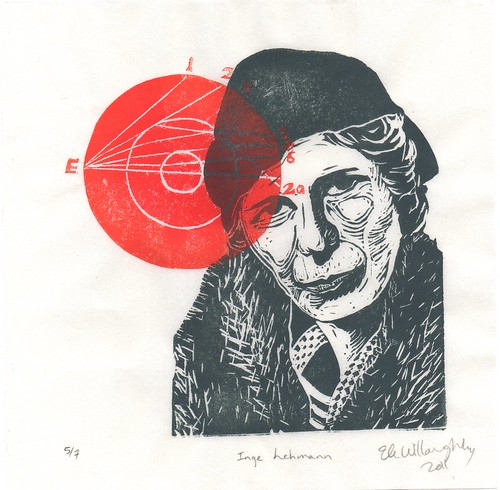 |
| Inge Lehmann, linocut, 8" x 8", by Ele Willoughby, 2011 |
Happy birthday to Inge Lehmann! Inge Lehmann (May 13, 1888 – February 21, 1993) was a Danish seismologist who first demonstrated that the Earth's core is not one single molten sphere, but contained an inner (solid) core, in 1936. She was a pioneer woman in science, a brilliant seismologist and lived to be 105, so I've selected her for my offering for the Mad Scientists of Etsy April challenge on earthquake seismology. Each is 8" (20.5 cm) square and printed in dark cyan and red-orange ink on white Japanese kozo (mulberry) paper.
We now know, as she first postulated, that the earth has roughly three equal concentric sections: mantle, liquid outer core and solid inner core. The crust, on which we live is merely a thin, um, scum really, on top of this slowly boiling pot. The only way to probe deep into the earth's core is to employ massive earthquakes, the waves they generate and the paths they follow. There are two main types of seismic waves used for studies of the globe, unimaginatively named Primary (or P, or compressional) and Secondary (or S, or shear). Imagine a glass of water with a straw; the straw will appear broken at the air-water interface, because light bends as it enters the water. Just like light travelling through different media, these seismic waves can bend, reflect or be transmitted at any boundary. The difference in physical properties between the mantle and outer core causes a P-wave shadow. (For S-waves, the shadow zone is absolute because liquids, like the outer core, do not support shear - imagine trying to cut water with a pair of shears and you can see this for yourself. Thus, no shear waves can make it through the outer core, and thus we can be certain the outer core is fluid). That means, the compressional waves from an earthquake can be recorded at seismic stations out to 105 degrees from an epicentre and then there is a zone which is in the core's shadow. Lehmann found that there were some late-arriving P-waves are much larger angles (142 to 180 degrees) which had been vaguely labelled 'diffractions'. She showed that these could be explained instead by deflections of the waves which travelled through the outer core at her postulated inner core boundary.
She later discovered a discontinuity in the mantle (confusingly also called the Lehmann discontinuity). She did important work well into her 70s.
When she received the Bowie medal in 1971 (she was the first woman to receive the highest honour of the American Geophysical Union), her citation noted that the "Lehmann discontinuity was discovered through exacting scrutiny of seismic records by a master of a black art for which no amount of computerization is likely to be a complete substitute...".
I think her accomplishment is downright astonishing. To have the exactitude to work with the data and the daring to neglect the irrelevant and offer up a simple, elegant - correct! - explanation is a rare and marvellous thing. To be the top of her field in 1936, when she was a pioneer for women in science and had to compete in vain with incompetent men (her words) is heroic.
I based my portrait on an earlier photo, to match the date of her phenomenal P' paper. I also show her model of the earth in red-orange ink, complete with mantle, inner and outer core, and travel paths for rays through the layers, including into the shadow zone.






No comments:
Post a Comment